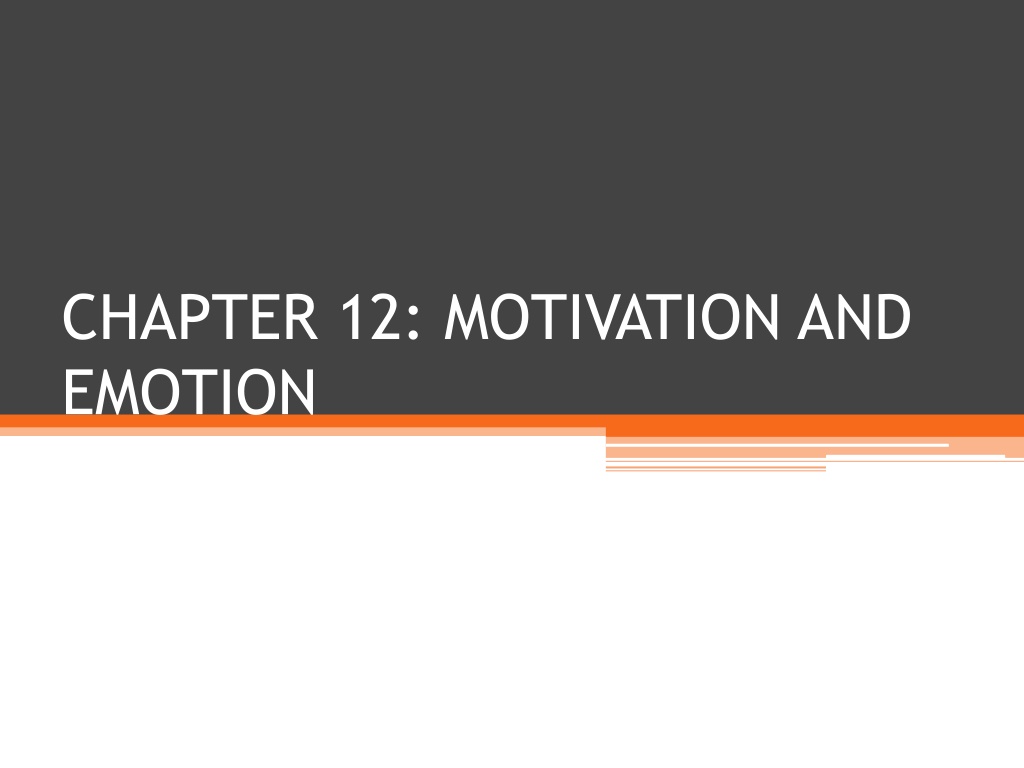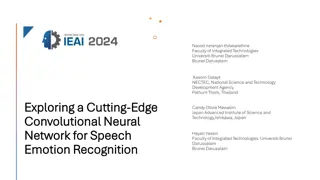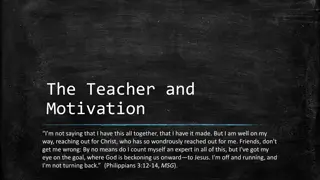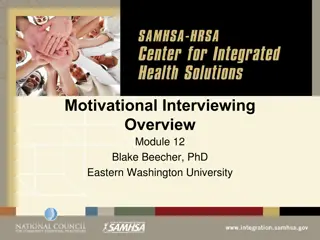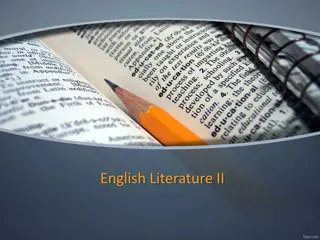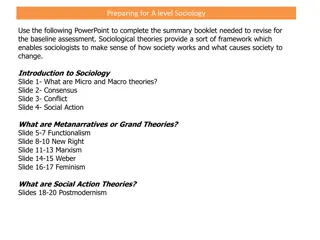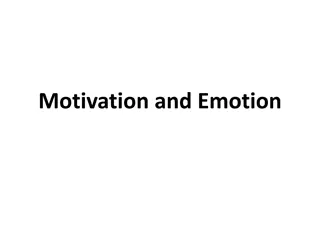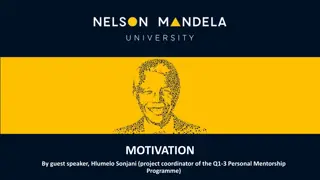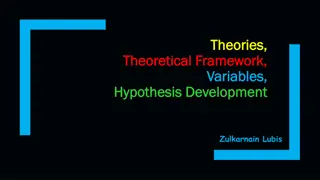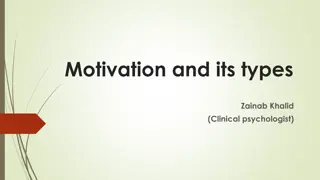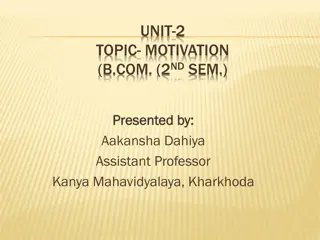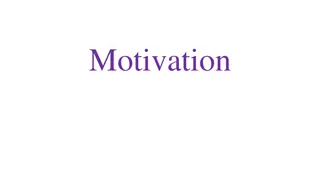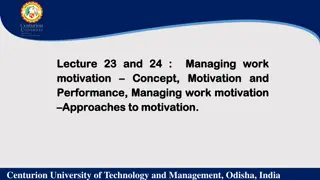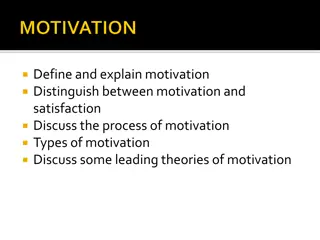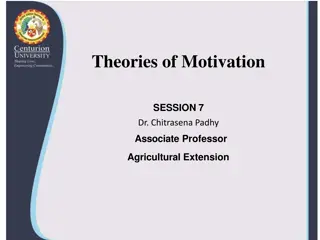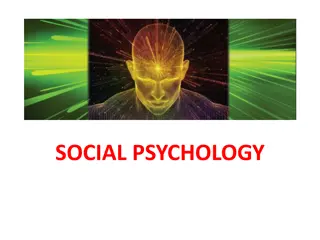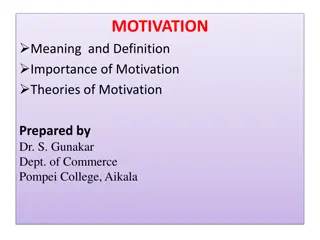Understanding Motivation and Emotion Theories
The chapter delves into various theories of motivation, including instinct theory, drive-reduction theory, incentive theory, and cognitive theory, explaining how internal states and external stimuli influence behavior. It also explores biological and social motives such as hunger and the roles of different parts of the hypothalamus. The content discusses intrinsic and extrinsic motivation, as well as the overjustification effect that impacts motivation levels.
Download Presentation

Please find below an Image/Link to download the presentation.
The content on the website is provided AS IS for your information and personal use only. It may not be sold, licensed, or shared on other websites without obtaining consent from the author. Download presentation by click this link. If you encounter any issues during the download, it is possible that the publisher has removed the file from their server.
E N D
Presentation Transcript
CHAPTER 12: MOTIVATION AND EMOTION
SECTION 1: THEORIES OF MOTIVATION
MOTIVATION Def: an internal state that activates behavior and directs it toward a goal Not readily observable Can be intrinsic, extrinsic, or both
INSTINCT THEORY Proposed by William McDougall (1908) Instincts: innate tendencies that determine behavior William James: human instincts include cleanliness, curiosity, parental love, sociability, and sympathy Do not explain behavior, they label it
DRIVE-REDUCTION THEORY Motivation starts with a Need: biological or physiological requirement of an organism Need produces a Drive: state of tension produced by a need that motivates an organism toward a goal
D-R CONTINUED Clark Hull Organisms are driven by Homeostasis: the tendency of all organisms to correct imbalances and deviations from their normal state Says all drives extend from biological needs Overlooks fact that some experiences are inherently pleasurable
INCENTIVE THEORY Incentive: an external stimulus, reinforcer, or reward that motivates behavior Drives push toward a goal, incentives pull
COGNITIVE THEORY Extrinsic motivation: engaging in activities that either reduce biological needs or help us obtain external incentives Intrinsic motivation: engaging in activities b/c they are personally rewarding or b/c they fulfill our beliefs or expectations Overjustification effect: intrinsic motivation declines when extrinsic motivation is used too much
SECTION 2: BIOLOGICAL AND SOCIAL MOTIVES
HUNGER Lateral hypothalamus (LH): part of the hypothalamus that produces hunger signals Ventromedial hypothalamus (VMH): part of the hypothalamus that can cause one to stop eating
GLUCOSTATIC THEORY AND SET-POINT Hypothalamus monitors glucose in blood Low levels activate LH, pancreas releases insulin Set-point: the weight around which your day-to-day weight fluctuates
PSYCHOLOGICAL FACTORS OF HUNGER External cues Sight, smell, social pressures, boredom, stress
OBESITY Obese: 30% or more above your ideal weight Overweight: 20% 31.8% of all Americans are obese Obese tend to eat more based on external cues
ACHIEVEMENT MOTIVE The desire to set challenging goals and persist in reaching those goals despite obstacles, frustrations, or setbacks McClelland s Thematic Apperception Test (TAT) High achievers: less need for intimacy; prefer to associate with experts who will help them achieve
FEAR OF FAILURE Choose to take easy tasks or impossible tasks w/no chance of success Make excuses All to maintain a positive self- image
FEAR OF SUCCESS Martina Horner Found fear of success was greatest in women with above average intelligence Exists in both sexes
EXPECTANCY-VALUE THEORY J.W. Atkinson Expectancy: estimated likelihood of success Value: what the goal is worth to you You weigh these when deciding
COMPETENCY THEORY We choose tasks of moderate difficulty to prove or improve our competency
MASLOWS HIERARCHY OF NEEDS Abraham Maslow (humanist) Levels of needs Fundamental needs: biological drives Psychological needs: urge to belong, to give and receive love, and to acquire self- esteem Self-actualization needs: needs to fulfill one s unique potential Research does not support claim that lower levels must be met first
SECTION 3: EMOTIONS What? You gonna cry about it?
EXPRESSING EMOTIONS Emotion: a set of complex reactions to stimuli involving subjective feelings, physical arousal, and observable behavior Charles Darwin said that all people express certain basic feelings in the same way Some facial expressions are innate
EXPRESSING CONTINUED Carroll Izard: coding system for assessing emotional states James Averill: many everyday emotional reactions are the result of social expectations and consequences---emotions can be changed by learning Expressions help describe emotion, but do not explain cause
JAMES-LANGE THEORY William James and Carl Lange Emotions are the perceptions of certain internal bodily changes Body reactions form the basis of labeling and experiencing emotion Critics: you don t run first and then feel fear Physiological changes may increase intensity of feeling
CANNON-BARD THEORY Walter B. Cannon and Philip Bard Certain experiences activate the thalamus and thalamus sends signals to the cortex and organs Brain sends 2 signals: arousal and experience of emotion Thalamus is not involved in emotion; the hypothalamus is
THE SCHACHTER-SINGER EXPERIMENT Stanley Schachter and Jerome Singer Emotion depends on a person s perception of the social situation When we don t understand our physical reactions, we take cues from the environment on how to react Perception and arousal create emotion
OPPONENT-PROCESS THEORY Richard Solomon and John Corbit Homeostatic theory of emotional reactions based on classical conditioning involving the sympathetic and parasympathetic NS When you remove a stimulus that excites one emotion, a swing is produced to an opposite emotion Emotions and physical reactions are intertwined
